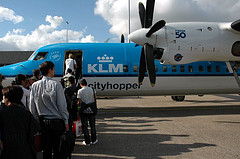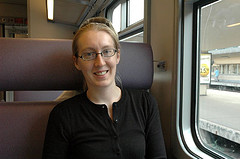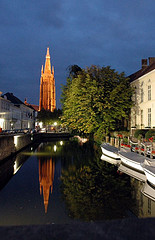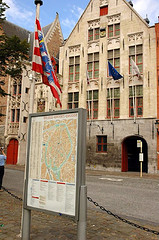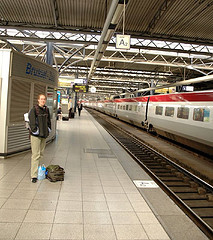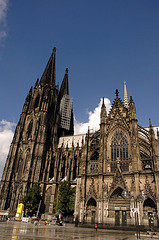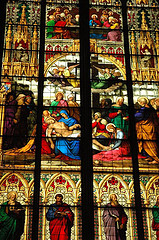Europe 2007 Trip Journal
Friday morning, August 31
We woke up in Seattle and caught a bus to the airport. On the way out, we cut a few Belgium-related pages out of one of the guidebooks, allowing us to leave the bulk of the book at home. We ran up the street to catch the 26 a little before noon, and just barely caught it! Smiling at one another, we got on the bus and headed downtown.
Our first flight was to Minneapolis and from there on to Amsterdam. The airport in Amsterdam is huge, and feels like a shopping mall! Our last hop was a little single-aisle propeller plane to Brussels.
We landed in Brussels a little after 6 (or, I suppose I should say 18:00), and made our way down the giant, tube-like airport concourse. We buzzed through "nothing to declare" and made our way to the railway station. Here, we bought two tickets to Brugge, via Brussels-Midi.
We got on the train which was waiting for us at the platform, and it was a short ride from the airport to the three railway stations in Brussels. First Nord, then Central, and finally Midi (Zuid), where we got off. Here, we changed trains to the one bound for Brugges. An hour later, we arrived!
We arrived in Brugge as it was getting dark, and had a nice walk through town as we made our way to the B&B where we stayed. We strolled through the cobblestone streets, finally feeling like our vacation had begun. The streets are so narrow, yet they're filled with people, horse-carts, and cars. Brugge very much caters to tourists, hence the horse-carts (and probably the cobblestones).
### Saturday, September 1 - Monday, Sept 3 We got up around 8:30 and headed down for breakfast, which consisted of ham, cheese, and rolls, plus some fruit, and tea/coffee. (Nearly every place we stayed had essentially the same breakfast, it must be very common in Europe!) From there, we set out to explore the town. Brugge is a very nice city, with cobblestone streets, canals, bell towers, and great waffles!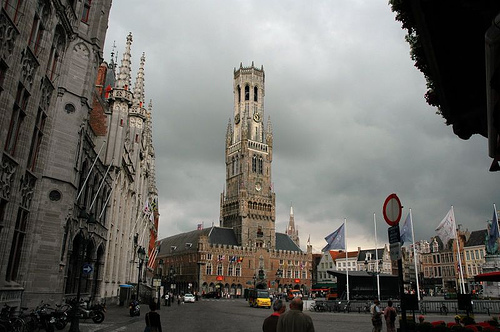
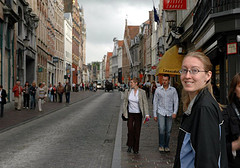
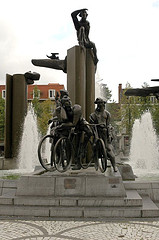 They make it easy for visitors who like to get lost (like us) with helpful map-signs printed in many languages at every major intersection or tourist attraction. The streets are also clearly labeled. (Their names are in Dutch, so most end in -straat for street. Though I kept saying -Strasse, as if they were German.)
The main town square is quite large, with an 83-meter belfry on the south end, and shops/restaurants lining the north and west ends. We walked up the spiral staircase to the top of the belfry. The stairs were narrow; when people going opposite directions met, one had to squish off to the side to make room!
There were a few rooms part-way up the tower, one used to be the town treasury. It contained a chest with 12 locks and 12 keys. Each was held by a different bishop or king or town official. (So all 12 had to be present to open it.)
Another room contained the Bell-machine, which was like a giant player-piano. It had a big metal roll, a meter or so in diameter, with metal pins pushed into it. It would spin around, and the pins would trigger the instrument chimes as they made contact. There was also a little room where a human could play the chimes on a keyboard. Apparently the town has a full-time organist playing there who occasionally goes on concert tours.) At the top of the Belfry were the bells themselves. There was also a magnificent view of the entire town in 360 degrees.
They make it easy for visitors who like to get lost (like us) with helpful map-signs printed in many languages at every major intersection or tourist attraction. The streets are also clearly labeled. (Their names are in Dutch, so most end in -straat for street. Though I kept saying -Strasse, as if they were German.)
The main town square is quite large, with an 83-meter belfry on the south end, and shops/restaurants lining the north and west ends. We walked up the spiral staircase to the top of the belfry. The stairs were narrow; when people going opposite directions met, one had to squish off to the side to make room!
There were a few rooms part-way up the tower, one used to be the town treasury. It contained a chest with 12 locks and 12 keys. Each was held by a different bishop or king or town official. (So all 12 had to be present to open it.)
Another room contained the Bell-machine, which was like a giant player-piano. It had a big metal roll, a meter or so in diameter, with metal pins pushed into it. It would spin around, and the pins would trigger the instrument chimes as they made contact. There was also a little room where a human could play the chimes on a keyboard. Apparently the town has a full-time organist playing there who occasionally goes on concert tours.) At the top of the Belfry were the bells themselves. There was also a magnificent view of the entire town in 360 degrees.
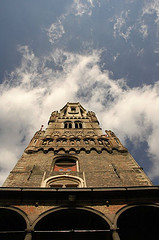
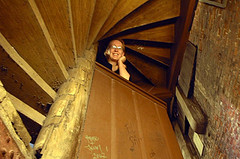
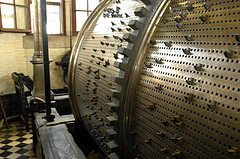
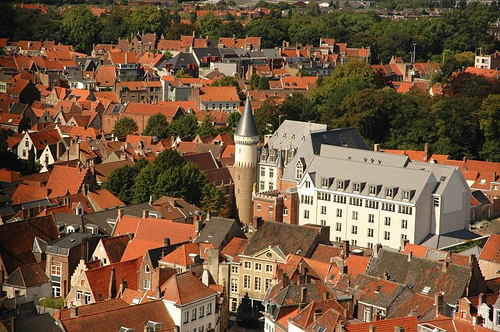
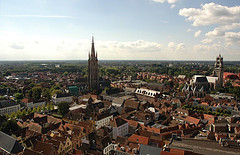
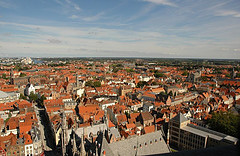
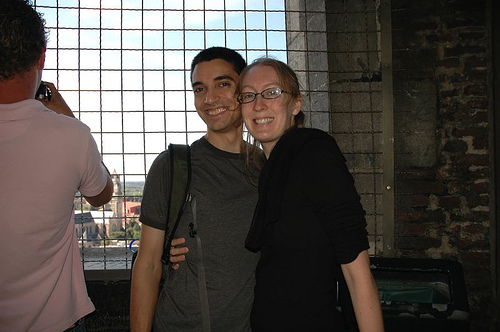 The town also has many canals. In medieval times, Brugge was a very important port.
The town also has many canals. In medieval times, Brugge was a very important port.
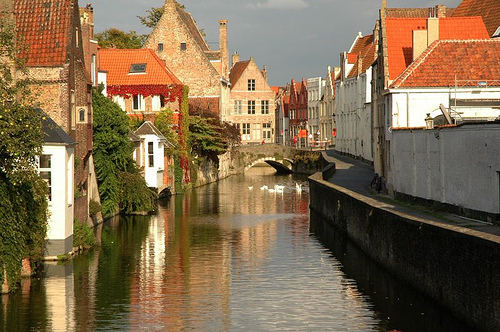
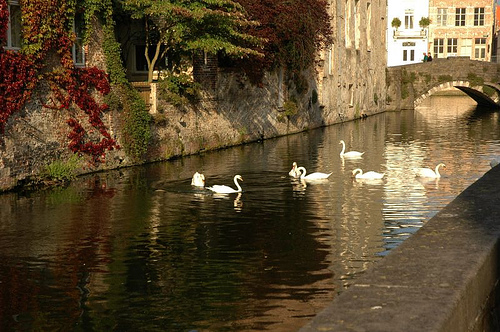 We went to a few museums and a few other misc sites. One of them was a brewery tour! The tour guide spoke Dutch, French, English and Spanish (all at the same time, which made for some long explanations!) He was constantly telling us about one kind of funny water (from the canal, the toilet, the rusty pipes, the roof, etc) which was (supposedly) used for beer they make to export to X country. (I kept waiting for the water which was used to export beer to the USA, but it never came up.) He also told us about the things they used to have children and poor workers do back in the 1800s. They would attach ropes to the children, then have them sing as they worked inside the vats of beer. When the kids stopped singing, the managers knew they had passed out due to the fumes and would pull them out with the ropes. (And send the next batch of kids in to takeover!)
A few more misc pictures from Brugge:
We went to a few museums and a few other misc sites. One of them was a brewery tour! The tour guide spoke Dutch, French, English and Spanish (all at the same time, which made for some long explanations!) He was constantly telling us about one kind of funny water (from the canal, the toilet, the rusty pipes, the roof, etc) which was (supposedly) used for beer they make to export to X country. (I kept waiting for the water which was used to export beer to the USA, but it never came up.) He also told us about the things they used to have children and poor workers do back in the 1800s. They would attach ropes to the children, then have them sing as they worked inside the vats of beer. When the kids stopped singing, the managers knew they had passed out due to the fumes and would pull them out with the ropes. (And send the next batch of kids in to takeover!)
A few more misc pictures from Brugge:
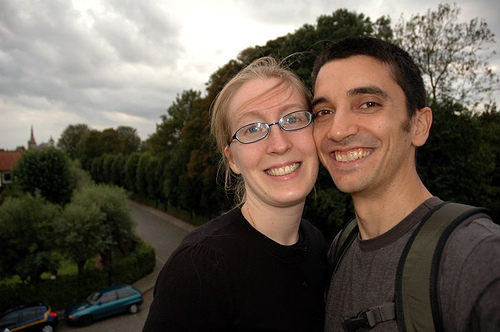
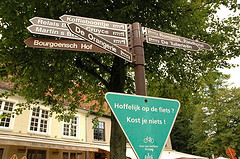
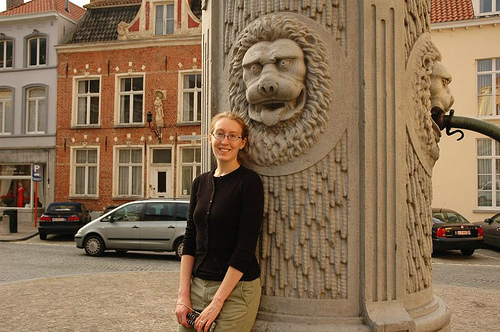
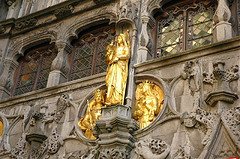
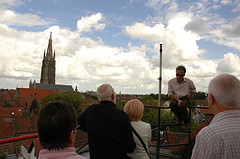
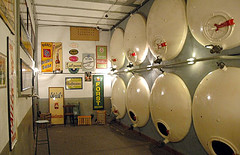
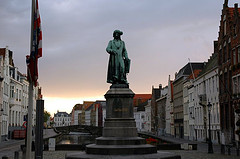 ### Tuesday, September 4 - Thursday, September 6
We woke up and took the train back to Brussels, stopped for coffee at the train station, and then headed into Germany. (We took the super-speedy Thalys train for this leg of the journey, which was great fun.) We changed trains in Koln, and briefly got out to see the cathedral. (Which is awe-inspiring, and too large to fit in my camera lens! Notice the tiny little people in the pictures. Then notice that each is only a portion of the cathedral!)
### Tuesday, September 4 - Thursday, September 6
We woke up and took the train back to Brussels, stopped for coffee at the train station, and then headed into Germany. (We took the super-speedy Thalys train for this leg of the journey, which was great fun.) We changed trains in Koln, and briefly got out to see the cathedral. (Which is awe-inspiring, and too large to fit in my camera lens! Notice the tiny little people in the pictures. Then notice that each is only a portion of the cathedral!)
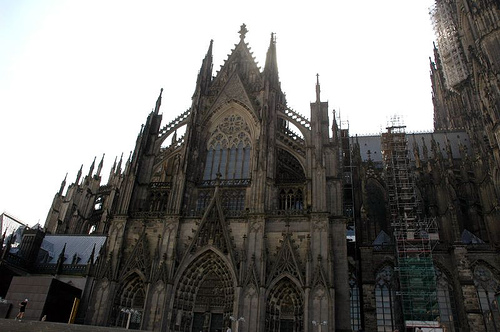 The cathedral is quite large, but the way it's so close to the station, you don't end up seeing it until you're right at its steps. Which makes it surprise you. Most of the time, you approach a large landmark from the distance, and it gets gradually larger and larger as you get closer and closer. But this one you don't see until you're on top of it. (And it really is big.)
From here, we took another train on, and stayed the next two nights along the Mosel and Rhine rivers. Our first night, we had a bit of a mixup with the youth hostel in Cochem. We thought we had confirmed our reservation, but the email must have never arrived because they were full! We nervously made our way back to the information desk in the town, hoping that we wouldn't have to sleep in the Bahnhoff, and they pointed us at a listing of local guesthouses. We found one only a few blocks away at a winery and decided to try it. (It was listed in the Rick Steves book.)
We arrived there amid a flutter of people wine-tasting. It was chaos! They were all middle-aged German (?) folks, and it kinda had the feel of a bunch of long-time fans of a particular college football team gathered around at a party after one of the games. People were milling and filling, and the busy hostess had four things to do with two hands. We managed to get her attention when things seemed (slightly) calm and quickly learned that my German was better than her English! We got the point across that we wanted ein Zimmer for eine Nacht, she took us to the room, explained what time breakfast was, asked us if we wanted coffee or tea in the morning (and what color tea), and then she quickly zoomed off again to get back to the wine tasters! Whee! It was great fun getting to speak German.
We put down our things and headed out again. Cochem is a rather small town, and fairly touristy -- though most of the tourists were German. It felt like a stereotypical 19th century German village, with the little alps-style houses, etc. It sounds (and was) a bit cheesy, but it was fun! We found a little pizza place to eat dinner, which was very down-to-earth and friendly.
After dinner, we walked through town and went to a little wine bar which was on a street leading up a hill towards the end of the center of town. The bar was down a bit from street level and had a really warm atmosphere -- 6-8 largish rectangular tables that were quite crowded, no music or anything, just people chatting. After that, we walked back to our room. It was dark and all the shops had closed for the night. We walked over one of the bridges to the other side of the river, back up the hill towards the Jugendherberge through a mostly residential neighborhood, stopped to try to take some pictures of an illuminated castle off in the distance, shivered a little (it was cold at night), and made it back to our Pension. We stopped at the Bahnhoff just before our hotel to check the train times in the morning, and it was largely deserted save for one late-night traveler. We were glad not to be sleeping here!
The next day we got up to catch another train to Moselkern. A was eager to take close-up photos of the many swans which swam in the river. She climbed down the bank a little, and got really close to them. They started chirping and flapping their wings and I thought she was going to get eaten! (Not really.) She climbed back up and we went to catch the train.
In Moselkern, we took a hike to a castle called Burg Eltz. We walked through town for 15 or so minutes, then through a residential neighborhood for another 15ish minutes (stopping to pet a few German cats.) Then we started along a footpath that eventually reached a hotel and then started on the trail itself. It felt a bit like hiking in the cascades -- the vegetation was a little different (no douglass firs), but there were other hikers coming and going every few minutes and you could imagine we were back in the states except people said "Hallo" instead of "Hello" as you passed.
We crossed the final ridge 45 minutes or so later, and the castle came into view! It was breathtaking, a well-preserved castle for 800 years. We went down into a final valley, crossed a stream (inhabited by kids playing), and walked up the steps to the castle. There, we ate our lunches and proceeded to the inside of the castle for a tour. The tour was in English (they sprinkle English-language tours in among the German tours). The castle was historically occupied by three families, with 1/3rd of the castle still being occupied by one family. The other 2/3rds of the castle are now an exhibit. We saw many rooms, old furniture, old tapestries, old kitchen utensils and cookware, old toilets that were flushed by collected rainwater on the roof flowing down through pipes, and old beds with wooden boxes on top of them with curtains (like a canopy, the purpose of which was to keep warm).
We saw many fireplaces, swords and other old weapons, suits of armor, and paintings. The chapels in the castle were positioned such that there were no rooms directly upstairs from them. (The roofs went to the sky.) This was because no one was supposed to be above God. There was one central room with two fireplaces on either side and a giant table in the middle -- this was the central meeting room of the castle, where the three families came together. There was a fool's mask on one wall (signifying that you could speak freely in this
room), and a rose on another wall (signifying that anything said in the room must not leave the room). One of the chapels had a stone (?) box which only opened into the next room (the kitchen). You built a fire in the box and it kept the chapel warm, but none of the smoke got into the chapel so it stayed clean.
After touring the castle, we hiked back down and took another train to Bacharach, where we'd stay that night. We checked into our guesthouse, put down our bags, and then went back out into the town. We took the little goat-path trail up the hill to the town castle, which had been converted into a Youth Hostel. It has a little cafeteria-style restaurant inside, and we got a snack and a beer there.
We left around 9:30, and it had gotten dark, How nice, but the goat path that we took up to the castle wasn't lit up! And I had left the flashlight in my bag in our room! Aah! There was no moonlight and the tree-covered path was very dark and steep downhill with steps and roots scattered all over. We stumbled a bit, and then used light from the LCD panel on A's camera to find the way down. 2/3rds of the way down the hill we started getting streetlights from the town and we could see enough without the camera.
The next day, we got up and took a train the the next town, St. Goar along the Rhine with a giant ruined castle.
It was not as well preserved as Burg Eltz, but pieces of it were still standing. We followed the self-guided walking tour in the Rick Steves book and spent 3-4 hours there; it was quite a large castle. At its height, the castle held 300 people. It had a giant pantry, a prison, a bakery, a brewery, a lookout tower, etc etc.
From here, we made our way to Frankfurt where we'd catch our overnight train to Prague. Some more pictures from Germany:
The cathedral is quite large, but the way it's so close to the station, you don't end up seeing it until you're right at its steps. Which makes it surprise you. Most of the time, you approach a large landmark from the distance, and it gets gradually larger and larger as you get closer and closer. But this one you don't see until you're on top of it. (And it really is big.)
From here, we took another train on, and stayed the next two nights along the Mosel and Rhine rivers. Our first night, we had a bit of a mixup with the youth hostel in Cochem. We thought we had confirmed our reservation, but the email must have never arrived because they were full! We nervously made our way back to the information desk in the town, hoping that we wouldn't have to sleep in the Bahnhoff, and they pointed us at a listing of local guesthouses. We found one only a few blocks away at a winery and decided to try it. (It was listed in the Rick Steves book.)
We arrived there amid a flutter of people wine-tasting. It was chaos! They were all middle-aged German (?) folks, and it kinda had the feel of a bunch of long-time fans of a particular college football team gathered around at a party after one of the games. People were milling and filling, and the busy hostess had four things to do with two hands. We managed to get her attention when things seemed (slightly) calm and quickly learned that my German was better than her English! We got the point across that we wanted ein Zimmer for eine Nacht, she took us to the room, explained what time breakfast was, asked us if we wanted coffee or tea in the morning (and what color tea), and then she quickly zoomed off again to get back to the wine tasters! Whee! It was great fun getting to speak German.
We put down our things and headed out again. Cochem is a rather small town, and fairly touristy -- though most of the tourists were German. It felt like a stereotypical 19th century German village, with the little alps-style houses, etc. It sounds (and was) a bit cheesy, but it was fun! We found a little pizza place to eat dinner, which was very down-to-earth and friendly.
After dinner, we walked through town and went to a little wine bar which was on a street leading up a hill towards the end of the center of town. The bar was down a bit from street level and had a really warm atmosphere -- 6-8 largish rectangular tables that were quite crowded, no music or anything, just people chatting. After that, we walked back to our room. It was dark and all the shops had closed for the night. We walked over one of the bridges to the other side of the river, back up the hill towards the Jugendherberge through a mostly residential neighborhood, stopped to try to take some pictures of an illuminated castle off in the distance, shivered a little (it was cold at night), and made it back to our Pension. We stopped at the Bahnhoff just before our hotel to check the train times in the morning, and it was largely deserted save for one late-night traveler. We were glad not to be sleeping here!
The next day we got up to catch another train to Moselkern. A was eager to take close-up photos of the many swans which swam in the river. She climbed down the bank a little, and got really close to them. They started chirping and flapping their wings and I thought she was going to get eaten! (Not really.) She climbed back up and we went to catch the train.
In Moselkern, we took a hike to a castle called Burg Eltz. We walked through town for 15 or so minutes, then through a residential neighborhood for another 15ish minutes (stopping to pet a few German cats.) Then we started along a footpath that eventually reached a hotel and then started on the trail itself. It felt a bit like hiking in the cascades -- the vegetation was a little different (no douglass firs), but there were other hikers coming and going every few minutes and you could imagine we were back in the states except people said "Hallo" instead of "Hello" as you passed.
We crossed the final ridge 45 minutes or so later, and the castle came into view! It was breathtaking, a well-preserved castle for 800 years. We went down into a final valley, crossed a stream (inhabited by kids playing), and walked up the steps to the castle. There, we ate our lunches and proceeded to the inside of the castle for a tour. The tour was in English (they sprinkle English-language tours in among the German tours). The castle was historically occupied by three families, with 1/3rd of the castle still being occupied by one family. The other 2/3rds of the castle are now an exhibit. We saw many rooms, old furniture, old tapestries, old kitchen utensils and cookware, old toilets that were flushed by collected rainwater on the roof flowing down through pipes, and old beds with wooden boxes on top of them with curtains (like a canopy, the purpose of which was to keep warm).
We saw many fireplaces, swords and other old weapons, suits of armor, and paintings. The chapels in the castle were positioned such that there were no rooms directly upstairs from them. (The roofs went to the sky.) This was because no one was supposed to be above God. There was one central room with two fireplaces on either side and a giant table in the middle -- this was the central meeting room of the castle, where the three families came together. There was a fool's mask on one wall (signifying that you could speak freely in this
room), and a rose on another wall (signifying that anything said in the room must not leave the room). One of the chapels had a stone (?) box which only opened into the next room (the kitchen). You built a fire in the box and it kept the chapel warm, but none of the smoke got into the chapel so it stayed clean.
After touring the castle, we hiked back down and took another train to Bacharach, where we'd stay that night. We checked into our guesthouse, put down our bags, and then went back out into the town. We took the little goat-path trail up the hill to the town castle, which had been converted into a Youth Hostel. It has a little cafeteria-style restaurant inside, and we got a snack and a beer there.
We left around 9:30, and it had gotten dark, How nice, but the goat path that we took up to the castle wasn't lit up! And I had left the flashlight in my bag in our room! Aah! There was no moonlight and the tree-covered path was very dark and steep downhill with steps and roots scattered all over. We stumbled a bit, and then used light from the LCD panel on A's camera to find the way down. 2/3rds of the way down the hill we started getting streetlights from the town and we could see enough without the camera.
The next day, we got up and took a train the the next town, St. Goar along the Rhine with a giant ruined castle.
It was not as well preserved as Burg Eltz, but pieces of it were still standing. We followed the self-guided walking tour in the Rick Steves book and spent 3-4 hours there; it was quite a large castle. At its height, the castle held 300 people. It had a giant pantry, a prison, a bakery, a brewery, a lookout tower, etc etc.
From here, we made our way to Frankfurt where we'd catch our overnight train to Prague. Some more pictures from Germany:


 ### September 7-9
We went to sleep on the night train and they woke us up to check our passports around 7ish am as we entered the Czech Republic. We arrived in Praha a little after 9. For the last 30-45 minutes of the journey, I joined A in standing out by the windows. (She had gotten up 30-60 minutes before me.) We watched as we buzzed through various Czech towns, the names of which were slavic-sounding and -spelled, different from the German towns we were buzzing through before. We chatted with an older couple from The Netherlands that was in the same compartment as us. It turns out that the a few of the other compartments in our train car were inhabited by firefighters from (some town). They were all on holiday together in Prague for the weekend. We were wondering what would happen if there was a fire in (that town) this weekend! We hoped there were backup firefighters in place!
### September 7-9
We went to sleep on the night train and they woke us up to check our passports around 7ish am as we entered the Czech Republic. We arrived in Praha a little after 9. For the last 30-45 minutes of the journey, I joined A in standing out by the windows. (She had gotten up 30-60 minutes before me.) We watched as we buzzed through various Czech towns, the names of which were slavic-sounding and -spelled, different from the German towns we were buzzing through before. We chatted with an older couple from The Netherlands that was in the same compartment as us. It turns out that the a few of the other compartments in our train car were inhabited by firefighters from (some town). They were all on holiday together in Prague for the weekend. We were wondering what would happen if there was a fire in (that town) this weekend! We hoped there were backup firefighters in place!
 We arrived in Prague and walked to our hotel. It was too early to check in, so we left most of our luggage at the hotel and then set out again. We got some Parekh V' Rohliku (I hope I'm spelling that right. Essentially, it's a Czech hot dog) at a stand in the park, then walked through Winceslas square (which is similar to the Champs d'Elesyes -- fancy pants shops, lots of tourists, overpriced everything, etc).
We arrived in Prague and walked to our hotel. It was too early to check in, so we left most of our luggage at the hotel and then set out again. We got some Parekh V' Rohliku (I hope I'm spelling that right. Essentially, it's a Czech hot dog) at a stand in the park, then walked through Winceslas square (which is similar to the Champs d'Elesyes -- fancy pants shops, lots of tourists, overpriced everything, etc).

 We went to museums (dedicated to Art Noveau paintings, Communism, etc.), went on walking tours, saw the Prague Castle, and had a busy time sight-seeing.
Prague's castle is a little bit different from the castles we saw in Germany in that it's still a functional building, not a ruin, and is very large. The huge cathedral, basilica, and other stuff are all _inside_ the castle itself. There was also a green building next to the basilica which used to house the secret police during the Communist time. The cathedral had a 287 step tower, which we climbed up.
We went to a Thai restaurant just outside the castle and A got "spaghetti" expecting something like Phad Thai. What she actually got was wheat noodles, not rice noodles! (Though with the sauce and vegetables of Thai food.)
Also in Prague, I also got to run a 10K race, which was great fun! It was a good race -- at night through the city. Sometimes on cobblestones, but most of the time on regular roads. We crossed the Vltava river twice, but neither time on the Charles Bridge. There was a band complete with electric guitars at one point, and people cheering at various times throughout. We did a few out and back sections and at the first one I got to see the leaders. They were waaay ahead of me! I finished the race in 43:07.
We went to museums (dedicated to Art Noveau paintings, Communism, etc.), went on walking tours, saw the Prague Castle, and had a busy time sight-seeing.
Prague's castle is a little bit different from the castles we saw in Germany in that it's still a functional building, not a ruin, and is very large. The huge cathedral, basilica, and other stuff are all _inside_ the castle itself. There was also a green building next to the basilica which used to house the secret police during the Communist time. The cathedral had a 287 step tower, which we climbed up.
We went to a Thai restaurant just outside the castle and A got "spaghetti" expecting something like Phad Thai. What she actually got was wheat noodles, not rice noodles! (Though with the sauce and vegetables of Thai food.)
Also in Prague, I also got to run a 10K race, which was great fun! It was a good race -- at night through the city. Sometimes on cobblestones, but most of the time on regular roads. We crossed the Vltava river twice, but neither time on the Charles Bridge. There was a band complete with electric guitars at one point, and people cheering at various times throughout. We did a few out and back sections and at the first one I got to see the leaders. They were waaay ahead of me! I finished the race in 43:07.

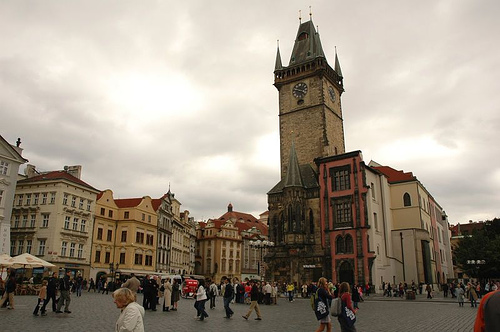


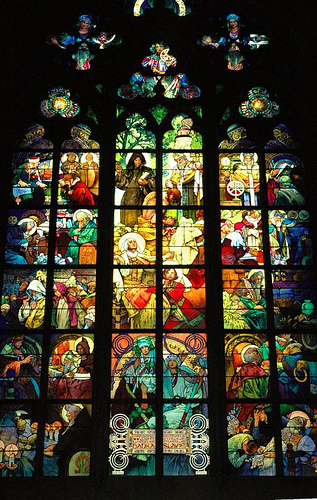

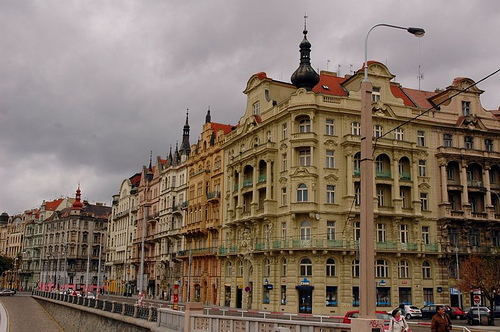
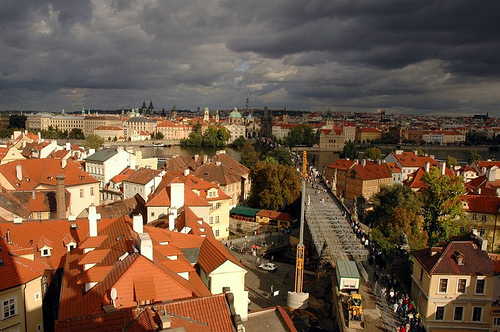
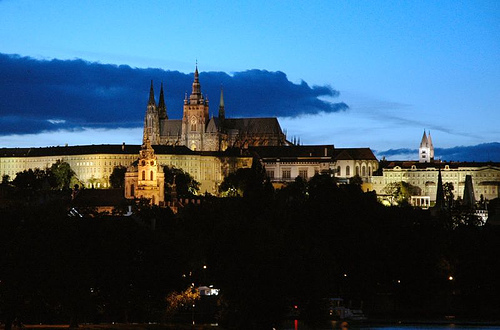 ### September 10-12
On Monday, we got up early and caught a bus to Cesky Krumlov. We took the metro from our hotel to the bus station (then had a bit of trouble finding the station as it's a few confusing blocks from the metro stop.) We got on the bus and made our way to Cesky Krumlov. This is a fun little town (largely a tourist town) in the southern Czech Republic. We checked into our hostel, and then walked through town again, stopping at Na Louzi, a restaurant recommended by Rick Steves. It was really good! A got to have Bramborak, and I had a chicken and potatoes dish that tasted great. The beer was good too, and the atmosphere was great.
Cesky Krumlov is a great place to relax -- it's easy to do nothing here, though there are sights to see too. We saw an old baroque theater, a castle tower, and walked around the streets of town too. One evening, we played cards with a bunch of Australian tourists who were also staying at our hostel. It was a really fun place (probably our favorite place on the trip.)
### September 10-12
On Monday, we got up early and caught a bus to Cesky Krumlov. We took the metro from our hotel to the bus station (then had a bit of trouble finding the station as it's a few confusing blocks from the metro stop.) We got on the bus and made our way to Cesky Krumlov. This is a fun little town (largely a tourist town) in the southern Czech Republic. We checked into our hostel, and then walked through town again, stopping at Na Louzi, a restaurant recommended by Rick Steves. It was really good! A got to have Bramborak, and I had a chicken and potatoes dish that tasted great. The beer was good too, and the atmosphere was great.
Cesky Krumlov is a great place to relax -- it's easy to do nothing here, though there are sights to see too. We saw an old baroque theater, a castle tower, and walked around the streets of town too. One evening, we played cards with a bunch of Australian tourists who were also staying at our hostel. It was a really fun place (probably our favorite place on the trip.)

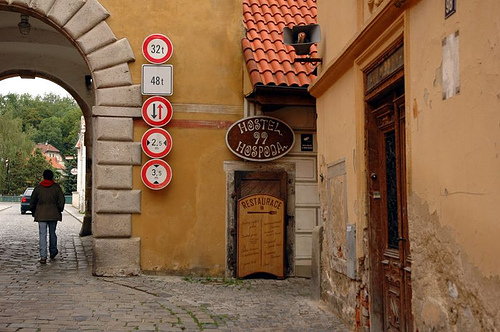
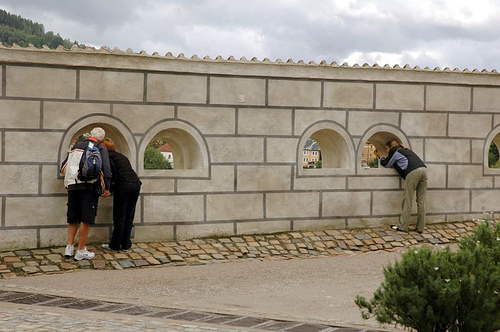
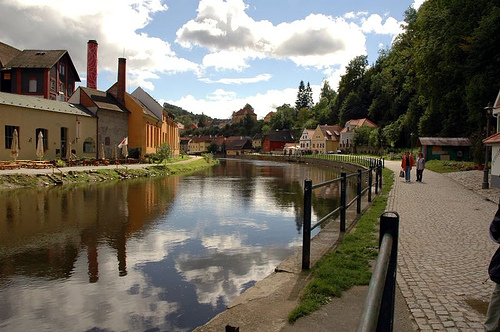
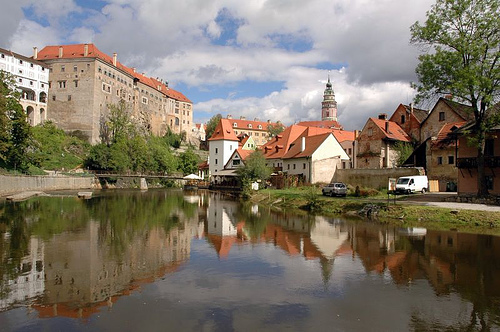 ### September 13-15
On Wednesday, we got up in Cesky Krumlov, and took a shuttle bus to Linz, Austria. From there, we took the train to Vienna, the last stop of our trip. Vienna is very much a big city -- in many ways it reminds me of Manhattan. All in all, it is a large, yet pleasant city. It has parks, ice cream stands, etc. We got a three day transit pass, and took trams, buses, and the metro all over. We saw a few museums and a Hapsburg Palace (at Schonbrun, containing the room where the armistice on 11/11/1918 was negotiated, plus the room where JFK met Nikita Kruschev). We saw the large ballroom where official parties were held. This was definitely a palace, not a castle. It wasn't built as a military fortress, instead a fancy residence.
### September 13-15
On Wednesday, we got up in Cesky Krumlov, and took a shuttle bus to Linz, Austria. From there, we took the train to Vienna, the last stop of our trip. Vienna is very much a big city -- in many ways it reminds me of Manhattan. All in all, it is a large, yet pleasant city. It has parks, ice cream stands, etc. We got a three day transit pass, and took trams, buses, and the metro all over. We saw a few museums and a Hapsburg Palace (at Schonbrun, containing the room where the armistice on 11/11/1918 was negotiated, plus the room where JFK met Nikita Kruschev). We saw the large ballroom where official parties were held. This was definitely a palace, not a castle. It wasn't built as a military fortress, instead a fancy residence.
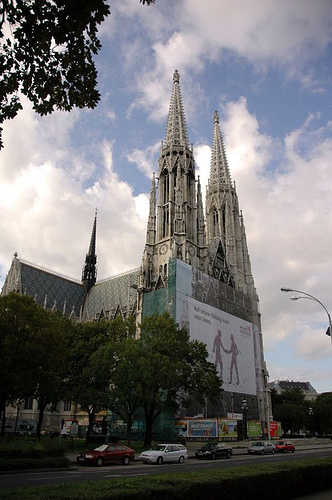
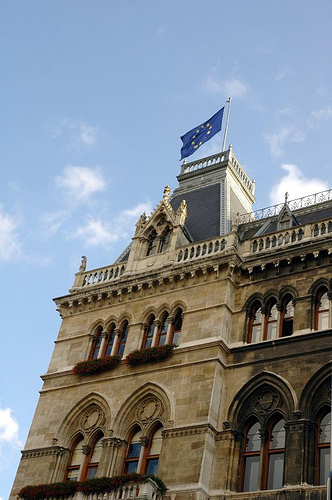
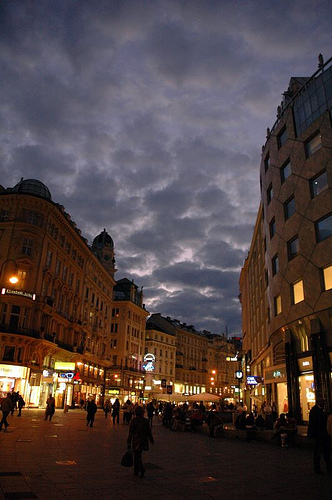
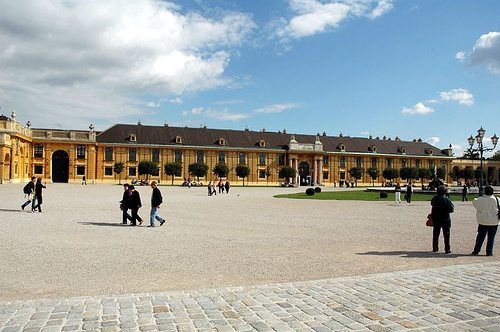
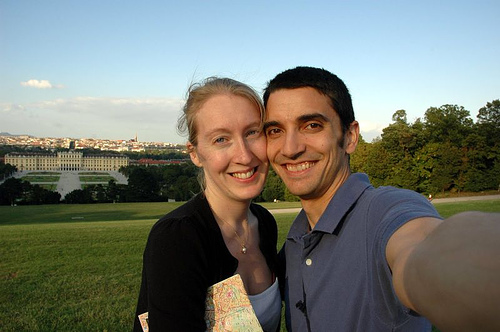
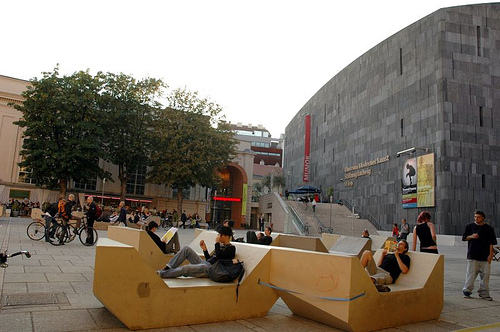 On the 15th, we woke up, checked out of our Pension, then left our bags there for the day. We went to a Starbucks for coffee and a donut -- it feels *exactly* like a Starbucks in the states. The tables are the same, the wall decorations are the same, the menu is the same, everything. We spent the day in Vienna, going to a couple more museums, then took a night train back to Koln.
From there, we took another train to Brussels for the last night of our trip. :-( We arrived in Bruxelles-Midi, took the local train back up to Bruxelles-Central, and walked out to the main town square. There was some kind of festival going on -- food and beer booths, a marching band/parade, and a stage with performances.
On the 15th, we woke up, checked out of our Pension, then left our bags there for the day. We went to a Starbucks for coffee and a donut -- it feels *exactly* like a Starbucks in the states. The tables are the same, the wall decorations are the same, the menu is the same, everything. We spent the day in Vienna, going to a couple more museums, then took a night train back to Koln.
From there, we took another train to Brussels for the last night of our trip. :-( We arrived in Bruxelles-Midi, took the local train back up to Bruxelles-Central, and walked out to the main town square. There was some kind of festival going on -- food and beer booths, a marching band/parade, and a stage with performances.
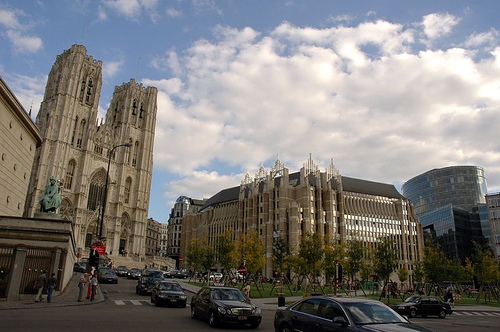
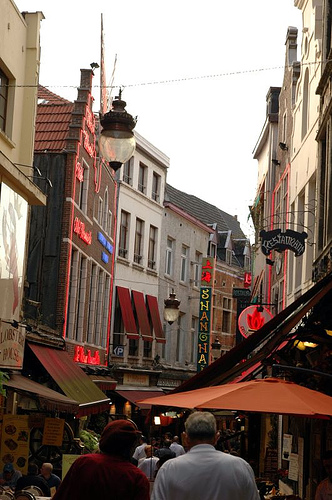
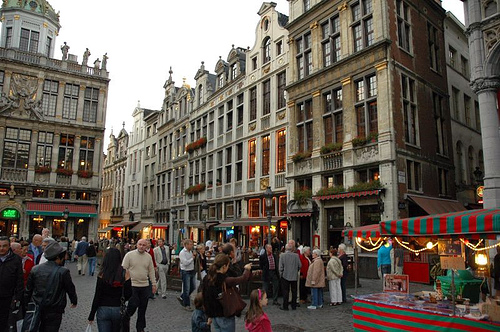 Here ends the journey. If you've enjoyed the photos, there are a zillion more of them up on
my flickr page. Cheers!
Here ends the journey. If you've enjoyed the photos, there are a zillion more of them up on
my flickr page. Cheers!
